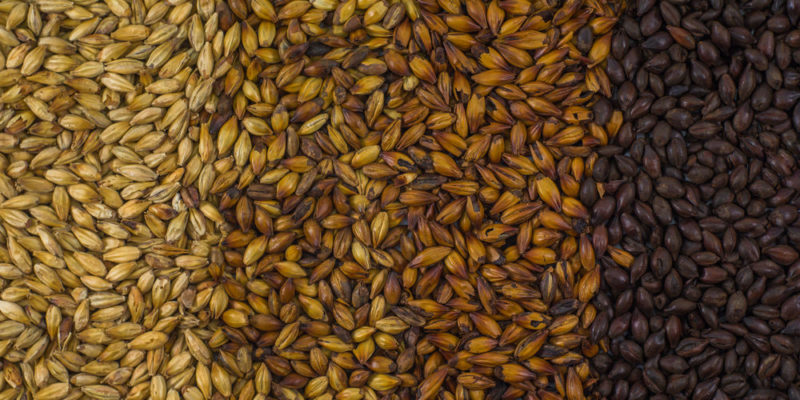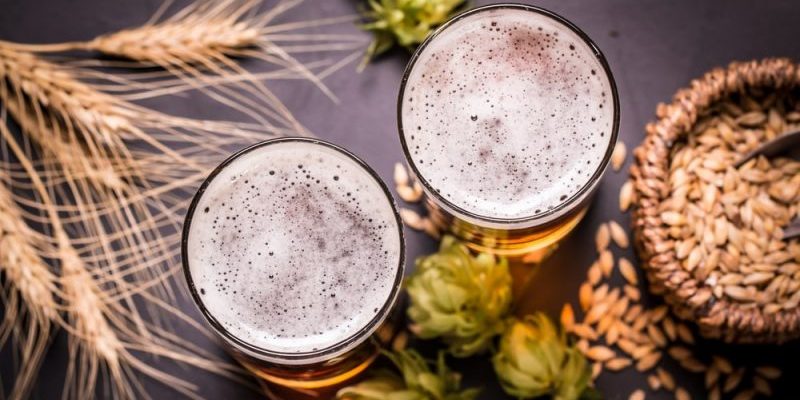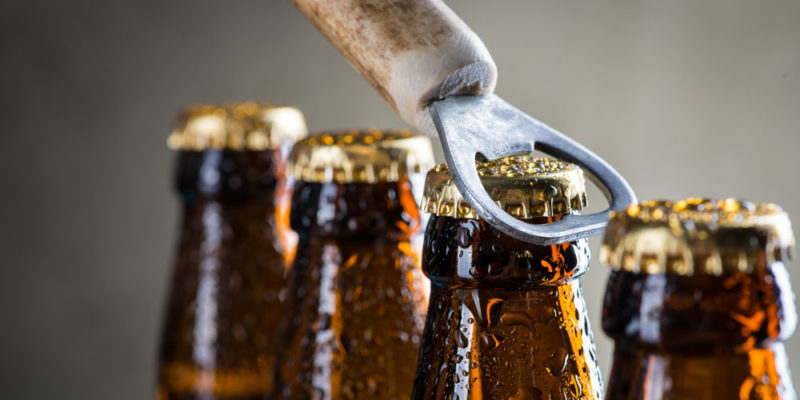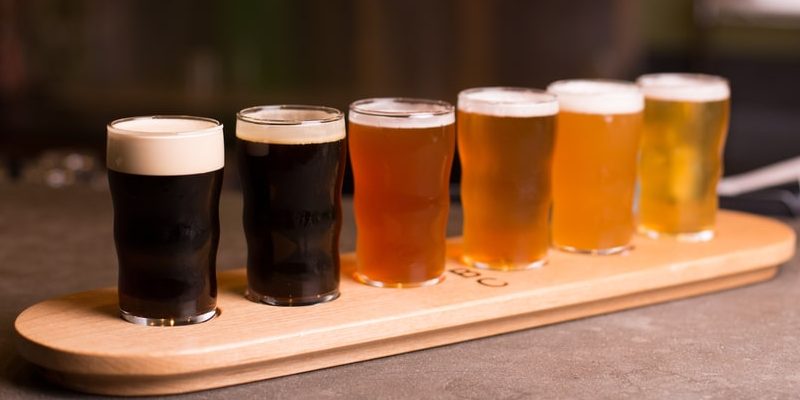We explain what beer is, how it is made, and the ingredients it uses. In addition, its characteristics and classification.
What is beer?
Beer is an alcoholic beverage made from the fermentation of barley or other cereals and flavored with hops or other plants.
Unlike other alcoholic beverages, it is not obtained from distillation. Due to all the manufacturing possibilities during fermentation and flavoring, there is a wide range of beer types and each manufacturer can add a personal characteristic to it.
Its origin dates back to 4,000 years BC and its consumption extended from the Middle East to the eastern coast of the Mediterranean. It spread throughout Europe since the fourteenth century.
Brewing beer

Brewing occurs in a series of stages that are not interchangeable:
- Grain mix. The chosen cereal grains (mainly barley) that are going to be converted into malt are mixed in the proportion indicated by each recipe, depending on the color and transparency that you want to obtain.
- Maceration. The grain is immersed in water at a temperature of 67 degrees. The mixture is then passed through various temperatures. At each chosen temperature an enzyme will be activated. In this way, the malt is produced. Once all the enzymes have been activated, they are destroyed by bringing the mixture to a temperature of 82 degrees.
- Filtered out. It allows you to remove the grain to leave available only the liquid that, thanks to the maceration, contains all the elements of the grain that are necessary for beer. This liquid is called wort.
- Cooking and additions. The wort is cooked for a variable period, which can be as short as 15 minutes or as long as two hours. The goal is to destroy any unwanted microorganisms and also to control the pH of the liquid. Hops are introduced during cooking.
- Refrigeration. It is done immediately after cooking to avoid contamination by new microorganisms.
- Fermentation. Yeast is added to the cooked must, which begins to reproduce rapidly thanks to the oxygen it finds in it. When oxygen is depleted, yeast consumes sugar, which is transformed into alcohol and carbon dioxide (CO2). Fermentation lasts between one and three weeks. Low-fermentation beers (lagers) have only one fermentation. Other beers are packed with a new addition of yeast and sugar, causing a second fermentation, which makes the beer fizzy.
- Maturation. The second fermentation can take place in controlled environments, in a period of between two weeks to three years.
- Pasteurization. Industrial beers are filtered after the first fermentation, pasteurized, and packaged. To achieve its effervescence, CO2 is added.
Beer cereals
In addition to barley, different cereals can be used in the raw, cooked, or malted state.
Malt is the state of the cereals after having gone through the maceration process. After maceration, the malt is roasted. If the toast is light, a light malt is achieved, which will result in a beer called lager or pale.
The higher the oven temperature, the darker the malt will be. The degree of toasting depends on the final color of the beer. Barley should always go through the malting process, but other grains can be roasted raw.
Aromatic beer additives

- Hop. It is used to balance the sweetness of the malt and can be bitter, aromatic, or mixed (which has both characteristics).
- Fruit. It is added during the preparation of beer before fermentation.
- Plants. In addition to hops, chestnut, rosemary, hemp, etc. can be added.
- Spices and others. Spices such as pepper or ginger can be added but also other edibles such as honey or wine.
Other beer ingredients
- Water. It constitutes between 85 and 92%, so it significantly affects the final result, depending on its levels of mineralization.
- Yeast. It is the essential ingredient for fermentation. It can be the yeast of high fermentation (obtaining ales) or low fermentation (obtaining lager).
Conservation of beer
 The quality of beer after being packaged can be affected by elements of the environment in which it is stored.
The quality of beer after being packaged can be affected by elements of the environment in which it is stored.Pasteurization allows it to have an extended shelf life of two months in barrels and six months in bottles and cans.
However, the product can be prematurely damaged by exposure to light, water, temperature, or strong odors in the place where it is stored.
Alcoholic graduation of beer
Beers have a variety of alcohol content: from 2.5% the lightest, 4.8 the commercial lager, to the world maximum of 67.5%, which is not usual in this type of drink.
Beer color
 Its color is determined by the raw material and the roast of the malt. The type of yeast used can also influence the final color of the beer.
Its color is determined by the raw material and the roast of the malt. The type of yeast used can also influence the final color of the beer.
Beer foam
It depends on the carbon dioxide that the beer contains at the time of serving it, as well as the proteins that it conserves at the end of the brewing process.
Brightness and transparency of the beer
 The beer should not be cloudy, since this characteristic indicates problems in the filtration process, some contamination of microorganisms or oxygen, or the loss of gas. This means that the appearance of the beer must be shiny and transparent.
The beer should not be cloudy, since this characteristic indicates problems in the filtration process, some contamination of microorganisms or oxygen, or the loss of gas. This means that the appearance of the beer must be shiny and transparent.
Types of beer
 Although there is a wide variety of beers, due to their characteristics, production process, or ingredients, the most common types are listed here:
Although there is a wide variety of beers, due to their characteristics, production process, or ingredients, the most common types are listed here:
- Ale. Top fermented beers. This fermentation lasts for three or four days, but it can also ferment for two weeks. It is done at a temperature of 25 degrees. In general, subsequent maturation is included in its production: hot maturation, cold maturation, or second fermentation in barrel or bottle.
- Lager. Low fermentation beers. It is a cold fermentation, close to 0 degrees. It is the most common beer today.
- Wheat. They are also top-fermented but include a significant percentage of wheat in their preparation. Its characteristic is its acidity, in addition to being refreshing and sparkling.
- Porter and stout. Dark beers, due to toasting. Porter is less bitter and has a lower density and alcohol content than Stout.
The above content published at Collaborative Research Group is for informational and educational purposes only and has been developed by referring to reliable sources and recommendations from technology experts. We do not have any contact with official entities nor do we intend to replace the information that they emit.
She has pursued her studies in The United States, where she has graduated in Business and Economics and is currently finishing her Master studies in International Economics and Finance. Miss. Amputee is fluent in three languages: English, Spanish and Russian and has elementary knowledge of French and Italian. She love exploring how Collaborative Research Group can become the best tool to achieve the (necessary) educational change. .
Leave a reply
Your email address will not be published. Required fields are marked *Recent post

Sport: What Is It, Types, Risks, Features, Characteristics and Examples

Dogs: Emergence, Features, Characteristics, Feeding and Breeds

Story: Definition, Elements, Structure, Features and Characteristics

